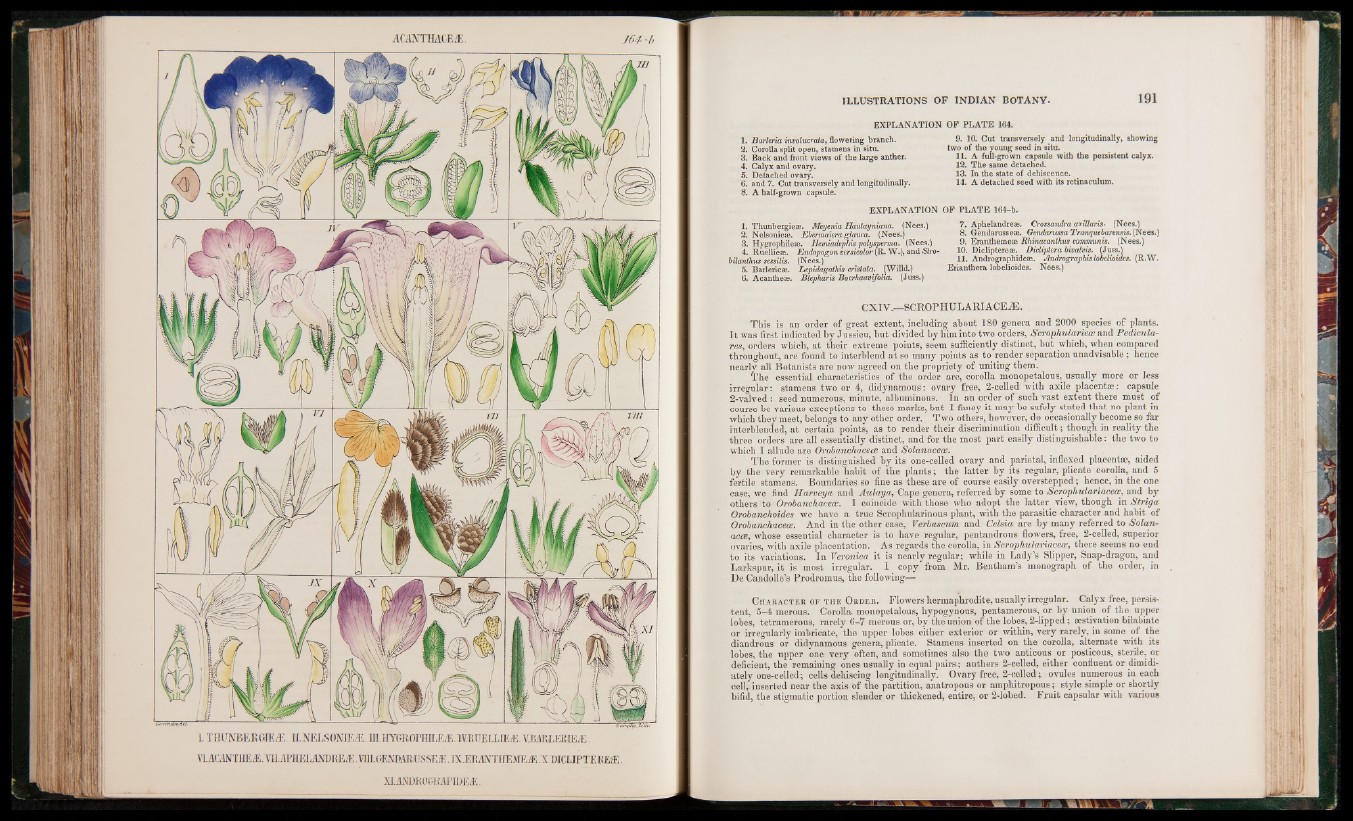
ACANTMCEÆ. J 6 4 -b
1.THUATBERGTEÆ. II/NELSONIEÆ;.lll.HYGBOPH[LEÆ.lV:UüELLIEÆ:.VÆiFvLEK,IEÆ.
YLACMTHEÆ.AALAPHELANDREÆ.W11.GENDARUSSEÆÏ.1X.ERANTHEMEÆ .XDICLIPTEREÆ.
XlASDROGEAPIDËiE.
EXPLANATION
1. Barleria involucrata, flowering branch.
2. Corolla split open, stamens in situ.
3. Back and front views of the large anther.
4. Calyx and ovary.
5. Detached ovary.
6. and 7. Cut transversely and longitudinally.
8. A half-grown capsule.
EXPLANATION
1. Thunbergieae. Meytnia Hautayniana. (Nees.)
2. Nelsonieae. Ebermaiera glauca. (Nees.)
3. Hygrophileae. Hemiadephis polysperma. (Nees.)
4. Ruellieae. Endopogon versicolor (R. W.), and Stro-
bUanthus sessilis. (Nees.)
5. Barlerieas. Lepidagathis cristata. (Willd.)
6. A can the«. Blepharis Boerhaavifolia. (Juss.)
OF PLATE 164.
9. 10. Cut transversely and longitudinally, showing
two of the young seed in situ.
11. A full-grown capsule with the persistent calyx.
12. The same detached.
13. In the state of dehiscence.
14. A detached seed with its retinaculum.
OF PLATE 164-b.
7. Aphelandreae. Crossandra axillaris• (Nees.)
8. Gendarusseæ. Gendarussa Tranquebarensis. (Nees.)
9. Eranthemeæ Rhinacanlhus communis. (Nees.)
10. Dicliptere*. Dicliptera bivalvis. (Juss.)
11. Andrographidese. Andrographislobelioides. (R.W.
Erianthera lobelioides. Nees.)
CXIV.—SCROPHULARIACEJE.
This is an order of great extent, including about 180 genera and 2000 species of plants.
It was first indicated by Jussieu, but divided by him into two orders, Scrophularieoe and Pedicula-
res, orders which, at their extreme points, seem sufficiently distinct, but which, when compared
throughout, are found to interblend at so many points as to render separation unadvisable; hence
nearly all Botanists are now agreed on the propriety of uniting them.
The essential characteristics of the order are, corolla monopetalous, usually more or less
irregular: stamens two or 4, didynamous: ovary free, 2-celled with axile placentae: capsule
2-valved seed numerous, minute, albuminous. In ah order of such vast extent there must of
course be various exceptions to these marks, but I fancy it may be safely stated that no plant in
which they meet, belongs to any other order. Tw.o others, however, do occasionally become so far
interblended, at certain points, as to render their discrimination difficult; though in reality the
three orders are all essentially distinct, and for the most part easily distinguishable: the two to
which I allude are Orobanchacece and Solanacece.
The former is distinguished by its one-celled ovary and parietal, inflexed placentae, aided
by the very remarkable habit of the plants; the latter by its regular, plicate corolla, and 5
fertile stamens. Boundaries so fine as these are of course easily overstepped; hence, in the one
case, we find Harveya and Aulaya, Cape genera, referred by some to Scrophulariacece, and by
others to- Orobanchacece. I coincide with those who adopt the latter view, though in Striga
Orobanchoides we have a true Scrophularinous plant, with the parasitic character and habit of
Orobanchacece. And in the other case, Verbascum and Celsia are by many referred to Solan-
acee, whose essential character is to have regular, pentandrous flowers, free, 2-celled, superior
ovaries, with axile placentation. As regards the corolla, in Scrophulariacece, there seems no end
to its variations. In Veronica it is nearly regular; while in Lady’s Slipper, Snap-dragon, and
Larkspur, it is most irregular. I copy from Mr. Bentham’s monograph of the order, in
De Candolle’s Prodromus, the following—
C h a r a c t e r of t h e O r d e r . Flowers hermaphrodite, usually irregular. Calyx free, persistent,
5-4 merous. Corolla monopetalous, hypogynous, pentamerous, or by union of the upper
lobes, tetramerous, rarely 6-7 merous or, by the union of the lobes, 2-lipped; aestivation bilabiate
or irregularly imbricate, the upper lobes either exterior or within, very rarely, in some of the
diandrous or didynamous genera, plicate. Stamens inserted on the corolla, alternate with its
lobes, the upper one very often, and sometimes also the two anticous or posticous, sterile, or
deficient, the remaining ones usually in equal pairs ; anthers 2-celled, either confluent or dimidi'
ately one-celled; cells dehiscing longitudinally. Ovary free, 2-celled; ovules numerous in each
cell, inserted near the axis bf the partition, anatropous or amphitropous; style simple or shortly
bifid, the stigmatic portion slender or thickened, entire, or 2-lobed. Fruit capsular with various